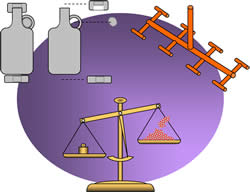Blending Applications

1. Regrind Problem: Process produces rejected or start-up parts/product that must be discarded or sold at a loss as regrind.
A common challenge to processors, trying to ensure maximum return on their raw material investment, is the production of rejects, either at start-up during process refinement, or as a part of the process (sprues, runners, edge trim, tabs and tails, etc). Most processors simply cannot endure the cost of rejected waste. Although selling this reground material can offset the cost to some degree, the best solution is to roll the regrind back into the process as quickly and as accurately as possible.
Solution: Regrind Dosing/Blending
The processor can easily determine the amount of regrind they can expect (compared to virgin material), the accuracy required when combining these two ingredients into the process and whether or not the supply of regrind will vary measurably during processing. Once these simple determinations are made, an appropriate dosing or blending device may be selected to assure a repeatable, accurate mix of the two materials.
Dosing: For very small amounts of regrind, a dosing device (volumetric or gravimetric) may be easily installed on the feed throat of the processing machine to meter regrind into the flow of virgin material, in pace with the processing rate. Typical features include the ability to meter only when the processing machine is accepting material (injection molding) or constant feed rates that are tied to the pace of the processing machine (extrusion). If needed, a mechanical or static mixing device can be added below the dosing mechanism to homogenize the mixed materials, before entering the feed throat.
Blending: For larger, or varying amounts of regrind, a blending device allows for automating the process of combining the two materials and includes a mixing process. Both virgin and regrind quantities are now measured by timed loading, dispensing or metering, and levels are monitored by the control in the event that material variations occur. Often times gravimetric load cells are employed so that minute changes can be sensed and accommodated automatically for the highest level of accuracy. Typically, these blending devices also include the ability to add additional additive dosing devices to them so that the measurement of all ingredients of the process are automatically controlled by a single blending unit.
- Color/Additive Introduction: Process requires the precise use of small quantities of (expensive) color or other additives.
In order to achieve the necessary product characteristics, additives are required for the final product to be produced. Pre-blending these additives manually with quantities of virgin, possibly along with regrind is time consuming, inaccurate and ingredients may be poorly mixed or even separate again prior to processing. Typically, in order to be sure that the necessary processing characteristic (i.e. color correctness) is achieved, more of the costly additive than is required is typically introduced. The process suffers from high cost, inaccuracy and poor repeatability.
Solution: Additive Dosing/Blending
Once the processor simply determines the amount of additive(s) required and the nature of those additives (powder, pellet) an appropriate automated device can be selected to blend the materials together, accurately, repeatedly and in-step with the process.
Dosing: For simple introductions of one or two additives, a dosing device (volumetric or gravimetric) may be easily installed on the feed throat of the processing machine to precisely meter the additive(s) into the flow of virgin and or virgin/regrind materials, in pace with the processing rate. Typical features include the ability to meter only when the processing machine is accepting material (injection molding) or constant feed rates that are tied to the pace of the processing machine (extrusion). If needed, a mechanical or static mixing device can be added below the dosing mechanism to homogenize the mixed materials, before entering the feed throat.
Blending: To fully control all of the materials required for the process, a blending device allows for automating the process of combining all materials and includes a mixing process. Virgin, regrind and the smaller, critical quantities of additives are now measured by timed dispensing or auger metering and all levels are monitored by the control in the event that material variations occur. Often times gravimetric load cells are employed so that minute changes can be sensed and accommodated automatically for the highest level of accuracy. A wide range of metering devices for the smaller additive amounts have been developed to allow not only extreme precision in the process, but to eliminate the need to “over-dose” to assure proper coloring. This sophisticated, yet simple to operate device, keeps track of all material dynamics to assure an accurate blend being delivered to the process with each and every cycle.
- Inaccurate dosing at the machine throat due to material variations or, the calibration process too time consuming.
Processors who have employed dosing devices at the processing machine throat may seek to further improve their process by moving to a higher level of accuracy. Calibrating the dosing device prior to starting the process for each new additive or job may be found to be time consuming or challenging for shop level workers. Inaccuracy and over-dosing are typical results. In addition, simple dosing may not accommodate variations in the regrind supply nor address variations in the additive’s flow characteristics.
Solution #1: Gravimetric Dosing
The use of a dosing unit that actually weighs the metered material permits rapid start-ups with only infrequent calibration of the unit itself to assure its weight measurements are accurate. Thereafter, only inputting the required feed rate into the dosing control is required. The gravimetric device assures that the proper dose of additive is provided by weight, with each and every metering cycle.
Solution #2: Gravimetric Blending
A blending device allows for automating the process of joining all materials and includes a mixing process. And because of its gravimetric load cells, all variations in the process are accommodated automatically for highly accurate, consistent results. Virgin, regrind and the smaller, critical quantities of additives are now measured by timed dispensing or auger metering and then weighed so all measurements are constantly corrected by the control in the event that material variations occur. The device needs only infrequent calibration to assure its weight references are accurate, and then each processing job or material variation requires only the inputting of the required rates into the control for set-up.



